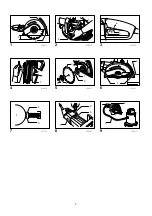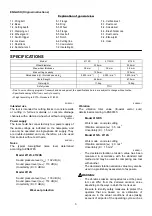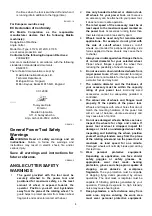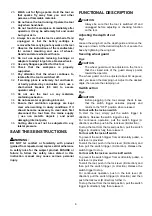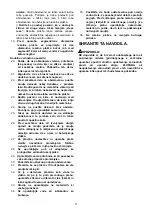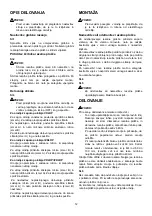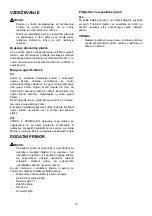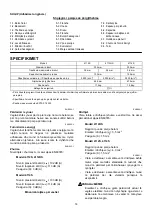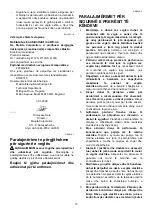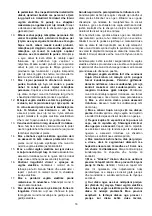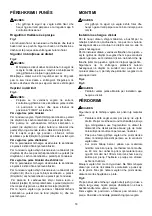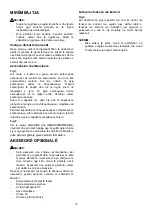
4
the times when the tool is switched off and when it
is running idle in addition to the trigger time).
ENH101-16
For European countries only
EC Declaration of Conformity
We Makita Corporation as the responsible
manufacturer declare that the following Makita
machine(s):
Designation of Machine:
Angle Cutter
Model No./ Type: 4112S, 4112HS, 4114S
are of series production and
Conforms to the following European Directives:
2006/42/EC
And are manufactured in accordance with the following
standards or standardised documents:
EN60745
The technical documentation is kept by:
Makita International Europe Ltd.
Technical Department,
Michigan Drive, Tongwell,
Milton Keynes, Bucks MK15 8JD, England
30.1.2009
000230
Tomoyasu Kato
Director
Makita Corporation
3-11-8, Sumiyoshi-cho,
Anjo, Aichi, 446-8502, JAPAN
GEA010-1
General Power Tool Safety
Warnings
WARNING Read all safety warnings and all
instructions.
Failure to follow the warnings and
instructions may result in electric shock, fire and/or
serious injury.
Save all warnings and instructions for
future reference.
GEB042-5
ANGLE CUTTER SAFETY
WARNINGS
1.
The guard provided with the tool must be
securely attached to the power tool and
positioned for maximum safety, so the least
amount of wheel is exposed towards the
operator. Position yourself and bystanders
away from the plane of the rotating wheel.
The
guard helps to protect operator from broken wheel
fragments and accidental contact with wheel.
2.
Use only bonded reinforced or diamond cut-
off wheels for your power tool.
Just because
an accessory can be attached to your power tool,
it does not assure safe operation.
3.
The rated speed of the accessory must be at
least equal to the maximum speed marked on
the power tool.
Accessories running faster than
their rated speed can break and fly apart.
4.
Wheels must be used only for recommended
applications. For example: do not grind with
the side of cut-off wheel.
Abrasive cut-off
wheels are intended for peripheral grinding, side
forces applied to these wheels may cause them
to shatter.
5.
Always use undamaged wheel flanges that are
of correct diameter for your selected wheel.
Proper wheel flanges support the wheel thus
reducing the possibility of wheel breakage.
6.
Do not use worn down reinforced wheels from
larger power tools.
Wheels intended for a larger
power tool are not suitable for the higher speed of
a smaller tool and may burst.
7.
The outside diameter and the thickness of
your accessory must be within the capacity
rating of your power tool.
Incorrectly sized
accessories cannot be adequately guarded or
controlled.
8.
The arbour size of wheels and flanges must
properly fit the spindle of the power tool.
Wheels and flanges with arbour holes that do not
match the mounting hardware of the power tool
will run out of balance, vibrate excessively and
may cause loss of control.
9.
Do not use damaged wheels. Before each use,
inspect the wheels for chips and cracks. If
power tool or wheel is dropped, inspect for
damage or install an undamaged wheel. After
inspecting and installing the wheel, position
yourself and bystanders away from the plane
of the rotating wheel and run the power tool at
maximum no load speed for one minute.
Damaged wheels will normally break apart during
this test time.
10.
Wear personal protective equipment.
Depending on application, use face shield,
safety goggles or safety glasses. As
appropriate, wear dust mask, hearing
protectors, gloves and shop apron capable of
stopping small abrasive or workpiece
fragments.
The eye protection must be capable
of stopping flying debris generated by various
operations. The dust mask or respirator must be
capable of filtrating particles generated by your
operation. Prolonged exposure to high intensity
noise may cause hearing loss.
11.
Keep bystanders a safe distance away from
work area. Anyone entering the work area
must wear personal protective equipment.


